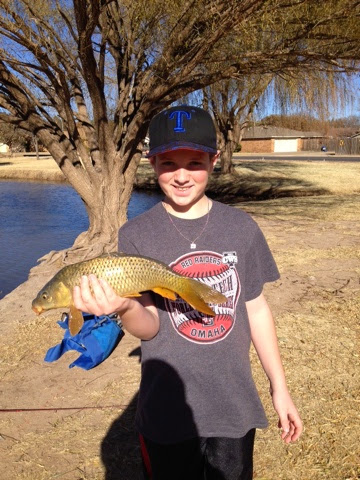You know I like to keep things simple. I'm not an advocate of using rigs that require an instructional manual and a Ph.D. to master. That's not fun, and there's no point in fishing if you're not having fun.
That said, the most successful fishermen put variety on their side. That's why I take at least three different types of bait on any given fishing trip. That's also why I use more than one rig.
During the spring and summer when the water's warm and the fish are active, the type of rig you use is almost irrelevant. If you put a split shot weight and a baited hook on the line, you're going to catch something.
As we've mentioned before, the same is not true in winter. Particularly in shallow bodies of water like ponds and playa lakes, the fish will head towards the middle, which is the deepest part. Unless we're talking about a puddle instead of a pond, a split shot weight isn't gonna get your bait out there in the middle.
That's where a slip sinker rig, also known as a Carolina rig, comes in. The one pictured below is a very basic version, but it's perfect if you're just beginning with this rig.
The weight has a hole in both ends. The main line runs through it freely. Hence the name slip sinker. See the close up below.
This has a couple of advantages. When you cast, that weight is going to slam against your swivel. From there, gravity and physics are going to carry your bait out. I mean WAY out.
I realize that the weight in the photo is very large, but guess what? The larger the weight, the farther your bait sails. This one literally carried mine to the center of the pond. That's important because in the winter you have to put the food in front of the fish. They won't expend the energy to come looking.
The other advantage of a slip sinker is that it holds the bait down while allowing the fish to take the hook without feeling the weight. The fish can run with the bait until any slack in the main line is gone. This provides a much better chance of the hook piercing the fish.
Enough about the weight. Next is the swivel. I've tied it to the main line using an improved fisherman's knot. If you use a larger weight, use a larger swivel. You don't want the weight to slip over the swivel. You want the swivel to STOP the weight. See below.
Notice the snap device on the bottom of the swivel. That's called an interlock snap. You can purchase swivels that come with them or swivels that don't.
I highly recommend purchasing swivels with snaps. The reason, again, is variety. Notice that I have a different line attached to the bottom of the snap. It's secured to the snap with a loop knot, which is the same knot used to tie a hair rig. See below.
Sorry about the way the hook looks. It happened to be flipped the wrong way when I layed it down for the picture. It's secured to the end of the braid with an improved fisherman's knot.
The complete rig is below. The main line is either 8 or 10 lbs monofilament. I honestly can't remember which. The slip weight comes first, and the main line is fed through it. Secured to the main line below the slip weight is the swivel with interlocking snap. It is secured with an improved fisherman's knot. Below the swivel and attached to the bottom of the snap is the 20 lbs braid, secured with loop knot. At the end of the braid is the hook, secured with an improved fisherman's knot. Pictured below is the whole rig. Sorry again that the hook's facing the wrong way.
Now here's the beauty of this rig. You can unhook the bottom of that snap. Since you made a loop knot, you can slide the braid and hook right off. Now why would you want to do that?
Let's say the catfish just aren't biting and you want to try for carp. You can remove this catfish rig, put together a hair rig, and secure it to the snap with a loop knot. Better yet, if you really want to be prepared, have some hair rigs ready to go in your tackle box. Then all you have to is unsnap, take one rig off, and put another one on.
The proof, as they say, is in the puddin' ... or in this case it's on the hook. All I got using a split shot and a nightcrawler was this little bullhead.
I tied a slip sinker rig with that heavy sliding weight and cast all the way to the middle of the playa lake, where I caught this guy.
He's not gonna break any records, but this channel catfish was right at keeper size. I tossed both fish back.
One last tidbit. That slip weight looks pretty old and corroded, right? I pulled that thing off of a lake bottom months ago, when my own line got tangled with the line it was on.
We've all pulled in a ball of someone else's old gear at some point. Obviously you don't want to keep rusty hooks, but let someone else's misfortune bless you. Re-use what you can. Then you'll be saving money and the environment!
Tight lines !

















































